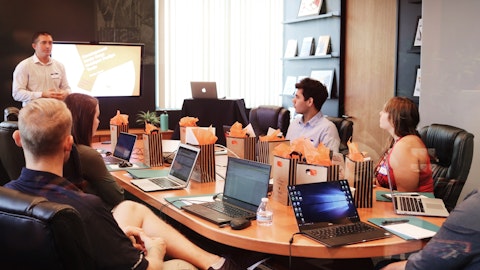Harte Hanks, Inc. (NASDAQ:HHS) Q1 2023 Earnings Call Transcript May 3, 2023
Operator: Greetings and welcome to the Harte Hanks’ First Quarter 2023 Earnings Conference Call. Please note this conference is being recorded. I will now turn the conference over to your host, Tom Baumann of FNK IR. You may begin.
Tom Baumann: Thank you. Hosting the call today are Brian Linscott, Chief Executive Officer; and Lauri Kearnes, Chief Financial Officer. Before we begin, I want to remind participants that during the call management’s prepared remarks may contain forward-looking statements that are subject to risks and uncertainties. Management may also make additional forward-looking statements in response to your questions today. Therefore, the company claims protection under the Safe Harbor for forward-looking statements contained in the Private Securities Litigation Reform Act of 1995. Actual results may differ from results discussed today and therefore we refer you to a more detailed discussion of these risks and uncertainties in the company’s filings with the SEC.
In addition any projections as to the company’s future performance represented by management include estimates as of today, May 2, 2023, and the company assumes no obligation to update these projections in the future as market conditions change. This webcast and certain financial information provided on the call, including reconciliations of non-GAAP financial measures to comparable GAAP financial measures are available in the earnings press release that was issued shortly after the market closed. A copy of that press release and other corporate disclosure is available on the Investor Relations section of Harte Hanks website at hartehanks.com. With that, I would now like to turn the call over to Brian. Brian, the call is yours.
Brian Linscott: Thank you, Tom, and good afternoon. We anticipated a challenging first quarter for Harte Hanks, but macroeconomic headwinds were stronger than we expected. However, despite the revenue challenges, we continued to generate positive EBITDA, demonstrating that we have established a strong business poised to successfully navigate macroeconomic challenges. We maintain positive EBITDA despite lower revenue levels versus the year ago period, which was artificially high as a result of one-time product recall project and pandemic-related projects. The fulfillment and logistics segment continued to grow. However, the year-over-year growth was driven by lower margin logistics revenue that was offset by reduced financial services revenue, resulting in less favorable revenue mix and lower overall EBITDA margins during the quarter.
Customer Care first quarter results were impacted by the conclusion of our federal and state funded pandemic-related projects that ended in the second half of last year. In addition, customer support for a few streaming clients experienced lower customer interactions and call volumes during the first quarter when compared to last year. The revenue declines were offset by increased revenue from our InsideOut acquisition. Marketing Services first quarter revenue was reduced versus first quarter 2022, largely driven by the roll off of direct legacy direct mail campaigns and reduced spend from B2B tech customers. Prior to the pandemic, our first quarter results were typically our seasonally lowest quarter of the year, but over the past few years, we benefited from the pandemic related projects, which muted the typical seasonality in our business.
We have now returned to a more seasonally reduced activity in the first quarter. However, we remain cautiously optimistic with the number of opportunities in the sales pipeline for the second half of the year and into 2024. For the second quarter, we expect sequential improvement in EBITDA, but our year-over-year quarterly comparison of EBITDA will continue to be pressured by a shift in revenue mix. We have seen customers begin to reevaluate their marketing, sales enablement, and logistics spend, most notably in financial services and B2B tech verticals to address perceived weakness in the prevailing economic environment. We have limited visibility beyond the second quarter, and we have reevaluated our expectations for the year. So our previously shared expectations for fiscal year 2023 are no longer relevant.
However, we are focused on preserving our profitability and we are taking the appropriate actions to right size our business and reduce discretionary spending in light of our first quarter performance and limited visibility beyond the second quarter. Our balance sheet remained strong. Last year, we eliminated the dilutive impact of our preferred shares, reduced our pension liabilities, and improved our overall cash position. In the first quarter, we received a $5.3 million federal tax refund that further strengthens our cash liquidity. As a result, we are pleased to announce the Board of Directors has authorized an expansion of our capital allocation strategy to include a $6.5 million share buyback. A repurchase program represents approximately 10% of Harte Hanks common shares outstanding at the current market price.
This action underscores the Board’s confidence and the strength of our balance sheet, as well as our ability to execute our strategy to maximize shareholder value and deliver sustainable profits. Today we are sharing a large initiative designed to meaningful strengthen our go-to-market strategy and improve our cost structure. We are combining our Marketing Services and Customer Care segments into one segment called Customer Experience. The combined segment will be led by Ben Chacko, who is previously responsible for our Customer Care segment. This segment will be organized into three key practice areas. One, professional services will include strategy, analytics, creative, and marketing technology. These capabilities will continue to be sold as a standalone offering with the intent of bundling and integrating these services into the other key areas.
listed below. Second, demand generation and sales strategy will be focused on engaging new prospects, scaling up lead qualifications, and accelerated lead progression. This practice area will include our lead generation capabilities, our data product, data view, and audience finder, and our sales capabilities through our recent acquisition of InsideOut. The third area is BPO managed services, which will include our traditional people and process outsourcing, which will include our marketing-as-a-service offer — offering, staff augmentation and our contact center capabilities. This practice area will focus on our proven capability of driving improved performance through scalable and efficient operations management. Today we have more than 10 clients that leverage the combined strength and integrated capabilities of Marketing Services and Customer Care.
We also have a handful of opportunities in our current sales pipeline, so we believe the integrated model will capture more wallet share and better position us for growth while improving our cost structure. We have seen that key decision makers reporting into marketing and customer experience roles within our clients and prospects. Our clients are more aggressively seeking ways to improve the customer experience. More — and more importantly, monetize it by leveraging data we capture during customer interactions and our marketing technology, we bring unparalleled ability to help our clients build loyalty and enhance growth. Additionally, with our InsideOut acquisition late last year, our digital and inside sales capabilities are improving the strategic positioning within our existing customer base and prospects.
Importantly, this has created more holistic discussions about ROI from marketing through better sales conversion. Harte Hanks differentiated offerings have unique ability to target customers showing intent and bring the targets through the sales funnel to improve our clients’ return on sales and marketing spend. Capturing return metrics and analytics are the best way to measure and repeat success. Combined Customer Experience segment will be better positioned to bring a wider range of capabilities and accelerate our digital transformation to meet our customers’ needs. Our investment in CRM technologies and automation data view and audience finder and telephony can further unlock opportunities to help our customers grow their business, improve their customer experience, and monetize loyal customers.
We are a customer-centric organization, and we believe that the Customer Experience segment that is fully integrated up and down the value chain will improve our global delivery model, as well as drive significant cost savings through overhead consolidations. For example, we will better leverage our talent in Romania and Philippines to serve our clients more efficiently at a lower cost on a global scale. As we all navigate the challenging macroeconomic environment, our current and potential customers are looking for ways to reduce costs wherever they can. Our ability to evolve and reposition our offering, bringing lower cost options to bear will benefit us, making us an increasingly attractive outsourcing option. The Reorganized Customer Experience segment will have an improved cost structure, and we anticipate meaningful cost savings through the consolidation and optimization efforts, and this process will continue into the third quarter.
Now, I’d like to turn the call to Lauri to cover the detailed financial results, and then I will return to cover new business and our sales pipeline.
Lauri Kearnes: Thank you, Brian. Turning to our Q1 results, revenues decreased 4% in the quarter to $47.1 million. Operating income decreased approximately $2.8 million or 73% compared to the first quarter last year. Our operating expenses for the first quarter were $46.1 million, up 2% from $45.2 million in the year ago quarter due to the change in the revenue mix resulting in higher transportation costs in our Fulfillment & Logistics segment. Our EBITDA decreased to $2.1 million from $4.5 million in the first quarter last year. Net loss for the quarter was $0.8 million, or a loss of $0.11 per basic and diluted share compared to net income of $3.3 million last year or $0.40 per basic and $0.39 per diluted share. The net loss was impacted by a $0.9 million non-cash currency loss compared to a $0.4 million gain on currency in the year ago quarter.
Turning to our operating segments, Customer Care revenue decreased 18.8% from the previous year and year-over-year EBITDA decreased 41% to $2 million from $3.5 million in the prior year quarter. The revenue decrease was due to a rolling off of recall and pandemic-related project work as anticipated, but streaming customer interactions were lighter than anticipated in the quarter as well. Our InsideOut business performed well and it contributed $2.8 million in revenue and $0.5 million in EBITDA for the quarter. Fulfillment & Logistics revenue increased approximately $3.1 million or 16.7% compared to the first quarter last year, and EBITDA decreased slightly to $2.2 million. While we continue to expect operational leverage and further benefits from consolidating our operations into the Kansas City and Boston facilities, we have experienced EBITDA margin compression resulting from a higher concentration of growth in our lower margin logistics revenue.
Our fulfillment operation experienced reduced volumes in financial services during Q1. That said, we are onboarding new customers in both facilities and we anticipate continued growth in the Fulfillment & Logistics segment. Finally, we continue to invest in technology. Our order management and warehouse management systems will be modernized starting in the third quarter of this year, and we anticipate having the ability to onboard new e-commerce clients in Q1 2024. This project will drive future efficiencies in the business, including plant operations, client administration, onboarding, reporting, and analytics. Marketing Services revenue decreased 13% to $11.2 million, and EBITDA decreased to $1.2 million. The largest driver of the year-over-year revenue decline relate to direct mail campaigns not continuing in the current quarter.
We also had project work conclude last year in the B2B tech vertical, and we continue to face challenges with growth given the macro environment. In conclusion, we believe we now have a sustainably profitable business model and multiple pathways for growth. We also believe that the combination of Marketing Services and Customer Care will improve our go-to-market offering, improve our delivery model, and further streamline our cost structure. Now turning to our balance sheet. As of March 31, 2023, we had cash and cash equivalent of $13.1 million compared to $10.4 million at December 31, 2022. Our combined long-term pension liability on the balance sheet as of March 31 was $36.8 million. As we announced in our Q4 earnings call, we are moving forward with a termination of our largest qualified pension plan.
We are on track to have that completed in the first half of 2024. As of March 31, 2023, we had no debt and maintain a $25 million credit facility. Now I would like to turn the call back over to Brian.
Brian Linscott: Thank you, Lauri. We’d like to share our new business wins and report on our sales pipeline. The Customer Care pipeline includes opportunities for longer term recurring revenue projects with current new and former customers, including inbound customer support for health care, pharma, government and consumer product verticals. Additionally, as previously noted, we have many opportunities with outbound demand generation and inside sales services. New wins for the quarter included a direct-to-consumer streaming support project for a sports streaming provider; and second, customer support for state’s implementation and execution of the National School Lunch Program, which provides low cost or free lunches for children.
Our Fulfillment & Logistics pipeline has opportunities with new clients and logistics, consumer brands and financial services, and we have near-term expansion opportunities with existing clients in CPG and pharma verticals. New client wins for the quarter included a growing national printing company that subscribe to our Alllink pricing and supply chain management software. Our automated pricing software will provide transparency for our client and provide the option of placing loads to our carrier network. Second, an international swimwear manufacturer selected Harte Hanks to fulfill North American e-commerce orders. The client was impressed by our Kansas City operation and will improve its distribution costs from our central location. Our Marketing Services pipeline has near-term opportunities with modest deals in account-based marketing data and demand generation projects.
We will benefit from a repositioned go-to-market offering and we will realign our resources, reduce our expenses, and invest in technology and infrastructure to better serve our customers. We remain focused on attracting new clients within prioritized market categories, including health care, pharma, financials, B2B tech and consumer product verticals. A new business win in the quarter included a biopharmaceutical company focused on therapeutic solutions has selected Harte Hanks to create and implement the strategic foundation of a global multi-channel patient support program. Where we sit today, I am cautiously optimistic about our business prospects for the rest of 2023, and I am confident in our ability to right size our costs in light of our first quarter results and tempered outlook on the second quarter.
Although our revenue shifts this year are challenging, it has allowed us to reorganize the company to better serve our customers, invest in and invest in growth that is meaningful for our future cash flows and value creation for the company. With that, I want to open up the line for questions. Operator?
Q&A Session
Follow Harte Hanks Inc (NASDAQ:HHS)
Follow Harte Hanks Inc (NASDAQ:HHS)
Receive real-time insider trading and news alerts
Brian Linscott: Yes. Hi, Michael. This is Brian. Thanks for the question. Good question and I agree obviously our tone has changed a little bit. We clearly seen the slowdown in — certainly some delays in projects. Some of the starts and new business opportunities we anticipated in the first quarter had been pushed out or otherwise reverted or even canceled. Not big long-term recurring revenue, but projects around marketing and campaigns. So I think that the tone and the reality is I think there’s a little bit of uncertainty in the marketplace and for now we just don’t have very clear visibility beyond the second quarter. That said, I think we’re well-positioned to weather the storm and obviously reshape and reposition our cost structure to make sure that we’re positioned well for growth in the future as well as delivering bottom line results.
Michael Kupinski: So can you kind of give us — you’re mentioning about the visibility beyond the second quarter. So obviously you can give us some thoughts about the second quarter. Can you kind of give us the tone of the business environment by segment for the second quarter in terms of revenues?
Brian Linscott: Yes. No, so if you go segment-by-segment Customer Care as an example is going to continue to have pandemic and recall revenue in the second quarter, that will be a challenge, right? Because we don’t have it this year, we got it in Q2. From a order of magnitude perspective on the revenue basis, it’s probably $2.5 million associated with pandemic and recall revenue that won’t recur. Now that said, I think we’re going to have improved activity and streaming in the second quarter. And we have InsideOut this year, right? And so, I think we — this first quarter at $2.8 million of revenue. So, I think that that directionally gives you some revenue perspective for the second quarter. When I look at Fulfillment & Logistics from a year-over-year perspective, we still will have a healthy increase in logistics revenue, albeit that that’s a little bit lower margin revenue.
The second quarter we’ve had a delay of a project or two from the first quarter that hopefully we’ll see some revenue in the second quarter for fulfillment. And then financial services in fulfillment is contracting a little bit. And so that’ll be a little bit of headwinds for the segment. Clearly I think we’re going to continue to see year-over-year growth. But that segment has a bit of the revenue mix challenge, right? And then when we look to Marketing Services into the second quarter, we still have a direct mail campaign that went off in Q2 at rather sizable. I think it was Lauri might have the specifics, but I think it was about $1.2 million of revenue. Direct mail margins aren’t quite as high as — of a typical Marketing Services margin business.
So that won’t recur in the second quarter. And we expect the B2B tech segment to still be a little bit soft. They’ve kind of pulled back on some of the spend. But we do see some opportunities in that segment as well. So, all in all, I would expect our revenue challenges for Marketing Services to be largely as a result of direct mail kind of rolling off.
Michael Kupinski: Got you. Some of the costs in your — in the quarter, in the first quarter, were actually a little lower than I expected. Did you start taking cost out of the business in the first quarter, or the cost reduction action that you’re talking about is largely a second and third quarter event?
Brian Linscott: Yes, I’d love to take credit, but it’s what we’re proposing is largely a second and third quarter event. Obviously, when, as an example, we have certain types of revenues, we lose — we have the ability to take a lot more direct cost in the particular quarter. But we fully anticipate to get a little leaner on the cost side in Q2 and 3, notwithstanding minor restructuring charges we might take.
Michael Kupinski: Right. And do you have any thoughts in terms of how much annualized cost you would like to take out, or your — what your plans are at this point?
Brian Linscott: So we’ve — I personally would like to take more than a couple million dollars out of the cost structure. I think we’re at the very preliminary stages. So, I’d rather not give the specific. I think coming the next quarter we’ll have a much clear view on what we’ll be able to do and how we can realign this kind of consolidated segment of Marketing Services and Customer Care into a more cost effective delivery model. And I do think there’s some really good opportunity there.
Michael Kupinski: What’s great about, I guess your position at this point had this been 2 years ago would’ve been a different story of going into some economic headwinds. You’re in a much stronger position to weather the storm at this point and really be well-positioned to grow up coming on the backside of it. So, congratulations at least getting your balance sheet in order and right-sizing the business prior to going into this — the downturn here. So, hats off to you for managing yourself through that. That’s all I have for now.
Brian Linscott: Thank you, Michael. I appreciate it.
Operator: The next question is from Julio Romero with Sidoti. Julio, please proceed.
Julio Romero: Thanks. Hey, good afternoon, Brian and Lauri. Maybe if I could ask about the reduced client spend. If you could just talk about how sharp that drop off in client spend was in March. Specifically, maybe the financial services portion of fulfillment. Did the regional banking crisis trigger that drop off in any way?
Brian Linscott: So, Lauri, you may need to help me if we’re talking specifically the month of March, but I guess what I would say, we do have some regional banks that we service, but many of our clients are very big, larger players. And I do think that the regional bank issue may have kind of trickled throughout the financial services industry. And so, I think there is a little bit greater tightening of the belt, so to speak, as it relates to multiple financial services clients for us. And that applies not only to Fulfillment, but also Marketing Services as well. When I look at the full quarter, the impact of financial services for Fulfillment & Logistics as an example was north of a $1 million in the quarter.
Julio Romero: Got it. That’s helpful. Maybe if you could talk about the decision to combine the two segments into one. I know you’ve talked in the past about wanting to tighten that fabric between the segments. So just maybe speak to the strategic rationale and maybe walk us through an example of, of how that can enable you to grow some wallet share.
Brian Linscott: Yes. So, I think I’ve been thinking about this for quite some time. One of the things that we did last year in the second quarter is we put Ben Chacko over international operations. And part of what that allowed him to do was get a more holistic view — operational view of our footprint. Ben Chacko is the Customer Care lead and now will be the Customer Experience lead. So, that was one of the steps in the process. And then Stacey Greene was the leader of tech development in Customer Care, and she now oversees both Marketing Services and Customer Care. And we did that in the third quarter of last year with the idea that we believe we had resources across the globe and talent with CRM technology that perhaps were being underutilized.
And so we’re still getting our arms fully around the complete kind of tech development footprint in our capabilities, but we’re seeing ways to leverage talent across both segments and certainly across the globe. And so to me, CRM technology, both from a marketing and a call perspective is extremely relevant. And I think that integrated fabric that we now have and will continue to kind of rally around will be a big asset and benefit for us because as we kind of begin to talk more and more with customers, and I was with a large health care system last week as an example, we do their inbound customer care for annual enrollment for a very large program. And one of the comments that they made to us was we really need to be able to find ways to grow our membership.
And with this combined footprint, we already do that for a variety of health care systems. What’s nice now is they can kind of see the power of this combined business because we not only have the telephony in data and analytics to drive improved customer experience, but we also have access to information that’ll help them drive membership growth. And so I think that meeting last week just opens my mind up to the additional opportunity that I truly see the power of this combined organization.
Julio Romero: Okay. That’s helpful. And then maybe on the share repurchase program, if you could maybe speak to the cadence of buybacks. How should we think about that, the deployment? How aggressive or conservative you think you’ll be with the share repurchase program?
Brian Linscott: Yes. So obviously I think we have a belief that we’re undervalued and we will certainly opportunistically buy back shares. There are rules and restrictions as a result of the size of our company. So, we will leverage as much as we can within the restrictions and guardrails set for a company of our size.
Julio Romero: Got it. Thanks for the questions and I’ll pass it on.
Brian Linscott: Thanks, Julio.
Operator: Okay. We have a follow-up coming from Michael Kupinski with Noble. Michael, please proceed.
Michael Kupinski: Yes. Thank you. I just have a quick. How much did InsideOut contribute in the quarter? And can you just tell us how that acquisition is performing at this point?
Brian Linscott: Sure.
Lauri Kearnes: Michael, I’ll take the contribution part. So the contribution was $2.8 million of revenue for the quarter and $0.5 million of EBITDA from that business.
Michael Kupinski: Okay. And — I’m sorry.
Brian Linscott: I’ll just add. Obviously, if you just simply annualized that contribution, in my mind is a great success. I think the thing that you can’t see right now, but as we reposition this customer experience business, we’re going to be able to leverage the sales strategy and the digital sales transformation initiatives that InsideOut provides for its clients and apply it internally to Harte Hanks. So, they will continue to have a bigger role in the way we drive growth. And I’m excited about the ability to position the offering collectively and change the way we go-to-market. So I think the acquisition, albeit was small, certainly is a great contributor to Harte Hanks.
Michael Kupinski: Got you. And then certainly I understand that you want to keep some liquidity on the balance sheet given the uncertain economic environment. But this InsideOut acquisition seemed like even though you said it was small, it seemed very compelling. Are there other acquisition opportunities that you see out there? Or is it likely that you’re going to focus on buying back stock and maintaining a healthy balance sheet? Or can you kind of give us some thought about M&A?
Brian Linscott: Yes. I think obviously we’re going to be opportunistic and we’re open to anything that expands and compliments our offering. That said, we’re taking on kind of a reorganization that’s going to require some focus and energy. And I think in the very short-term, that’s certainly where the focus of our business will be because it’ll not only protect our bottom line profits, but it’ll position us well for growth. And I think through that process, it will continue to kind of open our eyes to additional complimentary options out there that could be inorganic. And so, we’ll continue to explore, but we’ll be somewhat selective in the way we do it.
Michael Kupinski: Got you. Thank you. That’s all I have. Thanks.
Brian Linscott: Thank you, Mike.
Operator: We have no further — excuse me, we have no further questions in queue. We’ve reached the end of the question-and-answer session, and I’ll now turn the call over to management for closing remarks.
Brian Linscott: Thank you for your time today, and I look forward to updating you in a few months with our second quarter results. Certainly, if you have follow-up questions after today’s call, please feel free to reach out to Investor Relations and we’ll schedule a time to discuss further. Have a good day.
Operator: This concludes today’s conference, and you may disconnect your lines at this time. Thank you for your participation.
Follow Harte Hanks Inc (NASDAQ:HHS)
Follow Harte Hanks Inc (NASDAQ:HHS)
Receive real-time insider trading and news alerts





